
Tarragon, also known as estragon, is a species of perennial herb in the family Asteraceae. It is widespread in the wild across much of Eurasia and North America and is cultivated for culinary and medicinal purposes.

Thujone is a ketone and a monoterpene that occurs predominantly in two diastereomeric (epimeric) forms: (−)-α-thujone and (+)-β-thujone.

Artemisia is a large, diverse genus of plants belonging to the daisy family Asteraceae, with between 200 and 400 species. Common names for various species in the genus include mugwort, wormwood, and sagebrush.

Artemisia vulgaris, the common mugwort, is a species of flowering plant in the daisy family Asteraceae. It is one of several species in the genus Artemisia commonly known as mugwort, although Artemisia vulgaris is the species most often called mugwort. It is also occasionally known as riverside wormwood, felon herb, chrysanthemum weed, wild wormwood, old Uncle Henry, sailor's tobacco, naughty man, old man, or St. John's plant. Mugworts have been used medicinally and as culinary herbs.
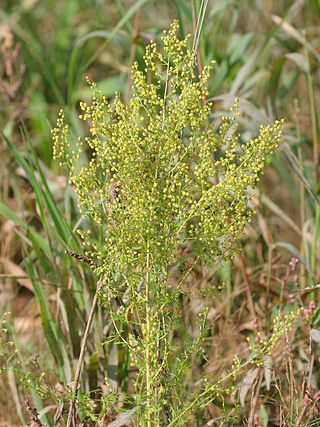
Artemisia annua, also known as sweet wormwood, sweet annie, sweet sagewort, annual mugwort or annual wormwood, is a common type of wormwood native to temperate Asia, but naturalized in many countries including scattered parts of North America.
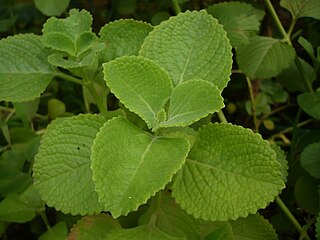
Coleus amboinicus, synonym Plectranthus amboinicus, is a semi-succulent perennial plant in the family Lamiaceae with a pungent oregano-like flavor and odor. Coleus amboinicus is considered to be native to parts of Africa, the Arabian Peninsula, and India, although it is widely cultivated and naturalized elsewhere in the tropics where it is used as a spice and ornamental plant. Common names in English include Indian borage, country borage, French thyme, Indian mint, Mexican mint, Cuban oregano, soup mint, Spanish thyme. The species epithet, amboinicus refers to Ambon Island, in Indonesia, where it was apparently encountered and described by João de Loureiro (1717–1791).

Angelica archangelica, commonly known as angelica, garden angelica, wild celery, and Norwegian angelica, is a biennial plant from the family Apiaceae, a subspecies of which is cultivated for its sweetly scented edible stems and roots. Like several other species in Apiaceae, its appearance is similar to several poisonous species, and should not be consumed unless it has been identified with absolute certainty. Synonyms include Archangelica officinalisHoffm. and Angelica officinalisMoench.

Artemisia absinthium, otherwise known as common wormwood, is a species of Artemisia native to North Africa and temperate regions of Eurasia, and widely naturalized in Canada and the northern United States. It is grown as an ornamental plant and is used as an ingredient in the spirit absinthe and some other alcoholic beverages.
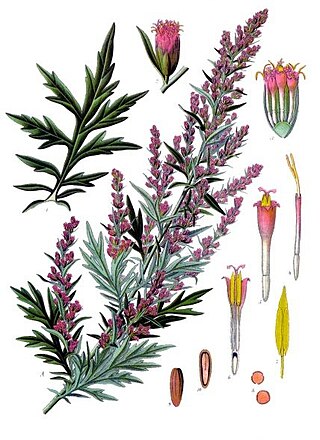
Mugwort or biboz is a common name for several species of aromatic flowering plants in the genus Artemisia. In Europe, mugwort most often refers to the species Artemisia vulgaris, or common mugwort. In East Asia the species Artemisia argyi is often called "Chinese mugwort" in the context of traditional Chinese medicine, Ngai Chou in Cantonese or àicǎo (艾草) in Mandarin. Artemisia princeps is a mugwort known in Korea as ssuk (쑥) and in Japan as yomogi (ヨモギ). While other species are sometimes referred to by more specific common names, they may be called simply "mugwort" in many contexts.

Eriocephalus africanus is a bushy shrublet indigenous to South Africa. It has a wide distribution in the Western and Eastern Cape, and in Namaqualand. The plant has several common names in various languages. It is known as the Kapokbossie or Wild Rosemary referring to its fancied resemblance to rosemary. The superficial resemblance is in the foliage, which, though softer and not glossy, grows in a habit similar to that of the common Mediterranean rosemary, although the two species are not related.

Artemisia douglasiana, known as California mugwort, Douglas's sagewort, or dream plant, is a western North American species of aromatic herb in the sunflower family.
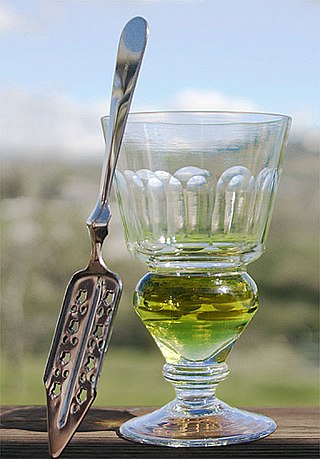
Absinthe is an anise-flavored spirit derived from several plants, including the flowers and leaves of Artemisia absinthium, together with green anise, sweet fennel, and other medicinal and culinary herbs. Historically described as a highly alcoholic spirit, it is 45–74% ABV or 90–148 proof in the US. Absinthe traditionally has a natural green color but may also be colorless. It is commonly referred to in historical literature as la fée verte. It is sometimes mistakenly referred to as a liqueur, but is not traditionally bottled with added sugar, so is classified as a spirit. Absinthe is traditionally bottled at a high level of alcohol by volume, but it is normally diluted with water before being consumed.

Monodora myristica, the calabash nutmeg or African nutmeg, is a tropical tree of the family Annonaceae or custard apple family of flowering plants. It is native to tropical Africa from Sierra Leone in the west to Tanzania. In former times, its seeds were widely sold as an inexpensive nutmeg substitute. This is now less common outside its region of production. Other names of calabash nutmeg include Jamaican nutmeg, ehuru, ariwo, awerewa, ehiri, airama, African orchid nutmeg, muscadier de Calabash and lubushi.
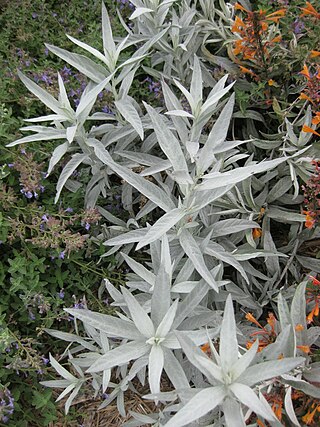
Artemisia ludoviciana is a North American species of flowering plant in the daisy family Asteraceae, known by several common names, including silver wormwood, western mugwort, Louisiana wormwood, white sagebrush, lobed cud-weed, prairie sage, and gray sagewort.

Artemisia biennis is a species of sagebrush known by the common name biennial wormwood. It is a common and widely distributed weed, so well established in many places that its region of origin is difficult to ascertain. This species is most likely native to northwestern North America and naturalized in Western Europe, and eastern and southern North America.

Artemisia herba-alba, the white wormwood, is a perennial shrub in the genus Artemisia that grows commonly on the dry steppes of the Mediterranean regions in Northern Africa, Western Asia and Southwestern Europe. It is used as an antiseptic and antispasmodic in herbal medicine.

Portulacaria afra is a small-leaved succulent plant found in South Africa. These succulents commonly have a reddish stem and leaves that are green, but also a variegated cultivar is often seen in cultivation. They are simple to care for and make easy houseplants for a sunny location. In frost-free regions they may be used in outdoor landscaping.

Artemisia argyi, commonly known as silvery wormwood or Chinese mugwort, is a herbaceous perennial plant with a creeping rhizome. It is native to China, Korea, Mongolia, Japan, and the Russian Far East. It is known in Chinese as àicǎo or ài yè or ài hao, in Japanese as Chōsen yomogi and in Korean as Hwanghae ssuk. It is used in herbal medicine for conditions of the liver, spleen and kidney.
Alpinia nigra is a medium-sized herb belonging to the ginger family. The rhizome is well known in many Asian cultures as a medicinal and culinary item. In many Asian tribal communities it is a part of the diet along with rice.
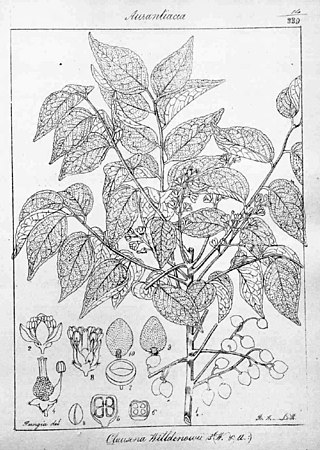
Clausena anisata (Willd.) Hook.f. ex Benth. is a deciduous shrub or small tree, belonging to the Rutaceae or Citrus family, and widespread in the Afrotropical realm or Sub-Saharan Africa, but absent from the drier regions. It is also found in tropical and South-East Asia, growing in India and Sri Lanka and extending as far as Queensland in north-eastern Australia and some Pacific islands. It is cultivated in Malaysia and Indonesia. As with other plants useful to mankind its large range of medicinal properties has led to a global distribution and its growth wherever the climate is suitable. It grows in higher-rainfall regions in savanna, thickets, riverine forest, disturbed areas and secondary forest, up to an altitude of 3000 m. The leaves, which are foetid when bruised, give rise to the common name 'Horsewood' or the more descriptive Afrikaans common name 'Perdepis', meaning 'horse urine'.



















